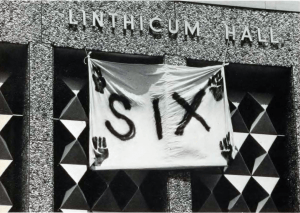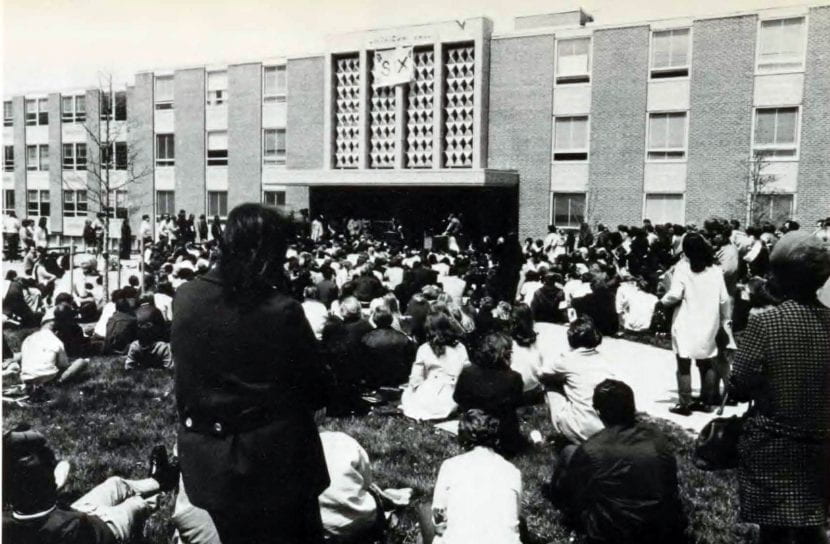When you think about college students in the United States during the 1960s or 1970s, what comes to mind? Perhaps you envision students filling campus sidewalks in protest of the Vietnam War or in support of the civil rights movement. Perhaps these students are members of organizations such as Students for a Democratic Society (SDS), Congress of Racial Equality (CORE), or their local chapter of the Student Nonviolent Coordinating Committee (SNCC). Above all, college students during these decades seemed to care deeply about a myriad of issues and decided to take action and address them. These are some of our first perceptions of student activists. From the perspective of 2021, the identities of “student” and “activist” seem to have been inextricably related during the 1960s and 1970s. We similarly conflate political activity and social unrest with college campuses as a whole during these two decades. While there is no denying that college students during the 1960s and 1970s played an integral role in many social movements, it is worth exploring how student activists were perceived at the time.
Today, student activists of the 1960s and 1970s understandably and deservedly receive a great deal of praise for their work and accomplishments. But were these activists similarly recognized and celebrated while they protested? Did they face opposition? If so, who made up the opposition and why did they question the work of student activists? To begin to answer these questions, this article will take a close look at how the administration of TU in the late 1960s and early 1970s, especially TU’s then-President James Fisher, perceived and responded to student activists. In accordance with this goal, this article will center the voices and viewpoints of TU administrators, not students. While incorporating multiple perspectives is crucial to the study of student activism, this article will hone in on one. Our previous post, “Students who agitate”: The Evolution of Student Activism at TU, emphasizes the voices and viewpoints of TU students and we hope to do the same in future posts. By analyzing how activists at TU were perceived by administrators in the 1960s and 1970s, we can begin to understand the relationship between the two groups and consider how conceptions of student activism have changed over time.
If we begin our consideration of perceptions of student activism in the late 1960s and early 1970s, we find Towson University students organizing and taking action around several key issues: the Vietnam War, racial justice, and women’s rights. At this time, campus administrators largely perceived student activists at TU as disruptive to the academic mission of the school. For example, when students protested the Vietnam War on campus in December 1969, many professors in Linthicum Hall, where the protest was staged, claimed that the activists were causing unwelcome disturbances to their teaching (Outten and Koot 2017). As a result, then-President James Fisher and Dean of Students Orielle Murphy went so far as to threaten the students with arrest if the protest continued to disrupt learning (Outten and Koot 2017). The students complied and the protest resumed, albeit at a lower volume. Following the event, the students held a student forum to allow “anyone to voice their opinion on communism and the Vietnam War” (Outten and Koot 2017). Notably, the forum did not attract any negative attention from professors or administrators, signaling that forums and discussions were viewed by campus administration as a more ideal form of activism than protests because they were less disruptive.

Following the 1969 Vietnam War protests and additional student unrest in the spring of 1970 following the fatal shootings of four Vietnam War protesters at Kent State University and two more at Jackson State, President Fisher addressed the activism that had taken place during the 1969-1970 school year at a meeting of the College Senate. The speech sheds light on Fisher’s perceptions of student activists as not only disruptive to the day-to-day activities of campus, but as a threat to the stability of the University as a whole. “Recent events on college campuses,” Fisher declared, “have demonstrated to me that there are those among us, right and left, who would do violence or induce others to violences, to achieve their ends” (Fisher 1970). Fisher continued, arguing that unless those recent events were “completely non-predictive,” it was safe to assume that disruptions would continue and perhaps lead to violence (Fisher 1970). Fisher also touted the successes that TU had achieved in 1970, noting that “the Towson State College community proved false the claim that only disruptive tactics can bring change to a College community” (Fisher 1970). Clearly, Fisher felt that there was a difference between student activists who sought to work through administrative avenues to meet their goals versus those who relied on protests, boycotts, or other forms of agitation to make their voices heard. Based on Fisher’s speech, it is not difficult to imagine the type of student activist that he would have viewed as ideal: a peaceful, participatory student who was willing to challenge the status quo, but not at the expense of the University.
In 1972, perceptions of student activists as disruptive to campus activities solidified as Fisher’s 1970 prediction that the campus would see further unrest rang true. Following the fatal shooting of two Black student protestors at Southern University (today known as Southern University and A&M College) a protest was held at TU that ultimately resulted in the arrests of four students. (The Sun 1972). The protest, held roughly two weeks after the deaths at Southern University, included the seizure of the school switchboard by four students, each of whom was arrested and ultimately given probation without verdict (Challmes 1973). Similar to his response to the Vietnam War protests, President Fisher painted the event as disruptive to learning, saying that the protest presented a “serious challenge to the academic freedom of the college community” (The Sun 1972).

According to The Sun, the students who seized the switchboard, backed by the Towson Peace Coalition and the TU chapter of Students for a Democratic Society, not only wanted to protest the Southern University killings, but also wanted to protest campus military recruiting, discriminatory hiring practices, and racist textbooks (The Sun 1972). Aside from the switchboard commandeering, TU students also mobilized for a “peaceful 10 A.M. campus rally” (The Sun 1972). Notably, Southern University was a Historically Black University (HBCU). Other HBCUs in Maryland, such as Coppin State, also held protests in the wake of the deaths at Southern University. The protest at Coppin took the form of a boycott, with students refusing to attend classes. According to Dr. Calvin W. Burnett, the president of Coppin State at the time, “more than 95 percent of [the] school’s 2,600 students boycotted classes” (The Sun 1972).
In the three years between 1969 and 1972, student activism at TU was particularly robust, prompting responses from both campus and local officials. A key component of student activism during this time was its communal nature; when students on other campuses mobilized, not just in Maryland but across the country, TU students were quick to do the same. This reality validates our modern-day perception of the terms “student” and “activist” being closely related during the 1960s and 1970s. It is also clear that college campuses were frequently sites for political activity and social unrest, which, in the eyes of administrators like Fisher, posed a threat to the university as an institution in part by disrupting learning. However, for many student activists (of the past and of the present), disruption is a necessary component of activism. From their perspective, the work is not at odds with the learning experience, it is part of the learning experience. In fact, despite his view of activism as disruptive, Fisher seems to have come around to the idea that student activism was a part of the learning experience, noting in his 1970 speech that the “tests” posed to the university by student activism were “part of the classic institutional evolution from passivity to creative activism” (Fisher 1970). Ultimately, while college administrators may have perceived student activism as a threat to their universities, they seem to have understood as well as we do today that student activism was and continues to be an integral part of the college campus.
—
References
Challmes, Joseph J. 1973. “4 students given probation for role in Towson takeover.” The Sun, April 20, 1973.
Fisher, James. “Statement Before the College Senate, July 1970.” Towson University Special Collections & University Archives, Records of the College Senate, UA 18, Ser. 3, Box 2, folder 1.
Outten, Liam and Christian Koot. 2017. “Linthicum Hall.” Last modified December 7, 2017. https://www.theclio.com/entry/50102.
The Sun. 1972. “4 arrested in Towson State protest.” The Sun, November 28, 1972.
Towson State College. Tower Echoes 1970 Yearbook. Baltimore, MD. Towson University Special Collections and University Archives. https://archives.towson.edu/Documents/Detail/tower-echoes-1970/18158.
